ECS LIVA Z5 PLUS mini-PC Review: A Different Take on Raptor Lake
by Ganesh T S on August 2, 2024 8:45 AM EST- Posted in
- Systems
- ECS
- Mini-PC
- LIVA
- LIVA Z
- Raptor Lake
- Raptor Lake-U
Digital Signage and Multimedia Credentials
The 2022 Q4 update to our system reviews brings an updated media playback evaluation suite for systems. After doing away with the evaluation of display refresh rate stability and Netflix streaming evaluation, the local media playback configurations have also seen a revamp. This section details each of the workloads processed on the ECS LIVA Z5 PLUS as part of the HTPC suite.
YouTube Streaming Efficiency
YouTube continues to remain one of the top OTT platforms, primarily due to its free ad-supported tier. Our HTPC test suite update retains YouTube streaming efficiency evaluation as a metric of OTT support in different systems. Mystery Box's Peru 8K HDR 60FPS video is the chosen test sample. On PCs running Windows, it is recommended that HDR streaming videos be viewed using the Microsoft Edge browser after putting the desktop in HDR mode.
The GPU in ECS LIVA Z5 PLUS supports hardware decoding of AV1, and we see the stream encoded with that codec being played back. The streaming is perfect, thanks to the hardware decoding support - the few dropped frames observed in the statistics above are due to mouse clicks involved in bringing up the overlay.
The streaming efficiency-related aspects such as GPU usage and at-wall power consumption are also graphed below.
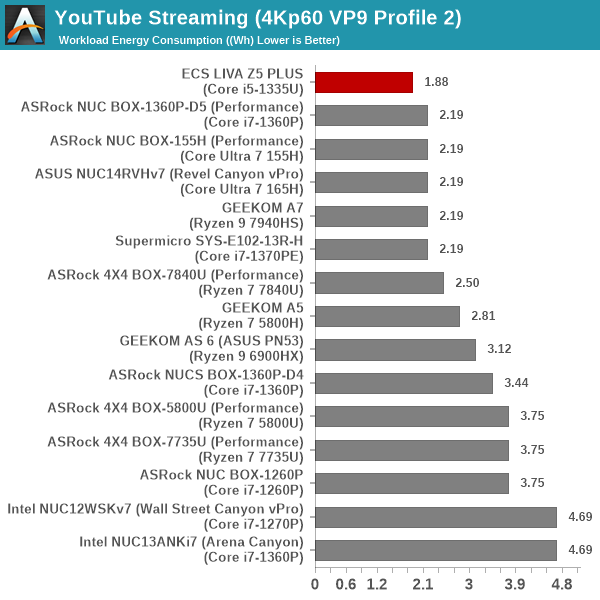
Interestingly, the energy consumption for the streaming workload is the lowest of all the compared systems. This shows that the combination of lower package power and clock rates may be quite beneficial if the system is good enough for the task at hand.
Hardware-Accelerated Encoding and Decoding
The transcoding benchmarks in the systems performance section presented results from evaluating the QuickSync encoder within Handbrake's framework. The capabilities of the decoder engine are brought out by DXVAChecker.

Video Decoding Hardware Acceleration in ECS LIVA Z5 PLUS
The iGPU in the Core i5-1335U supports hardware decode for a variety of codecs including AVC, JPEG, HEVC (8b and 10b, 4:2:0 and 4:4:4), and VP9 (8b and 10b, 4:2:0 and 4:4:4). AV1 decode support is also present. This is currently one of the most comprehensive codec support sets seen in the PC space.
Local Media Playback
Evaluation of local media playback and video processing is done by playing back files encompassing a range of relevant codecs, containers, resolutions, and frame rates. A note of the efficiency is also made by tracking GPU usage and power consumption of the system at the wall. Users have their own preference for the playback software / decoder / renderer, and our aim is to have numbers representative of commonly encountered scenarios. Our Q4 2022 test suite update replaces MPC-HC (in LAV filters / madVR modes) with mpv. In addition to being cross-platform and open-source, the player allows easy control via the command-line to enable different shader-based post-processing algorithms. From a benchmarking perspective, the more attractive aspect is the real-time reporting of dropped frames in an easily parseable manner. The players / configurations considered in this subsection include:
- VLC 3.0.20
- Kodi 21.0
- mpv 0.38.2 (hwdec auto, vo=gpu-next)
- mpv 0.38.2 (hwdec auto, vo=gpu-next, profile=gpu-hq)
Fourteen test streams (each of 90s duration) were played back from the local disk with an interval of 30 seconds in-between. Various metrics including GPU usage, at-wall power consumption, and total energy consumption were recorded during the course of this playback.
All our playback tests were done with the desktop HDR setting turned on. It is possible for certain system configurations to automatically turn on/off the HDR capabilities prior to the playback of a HDR video, but, we didn't take advantage of that in our testing.
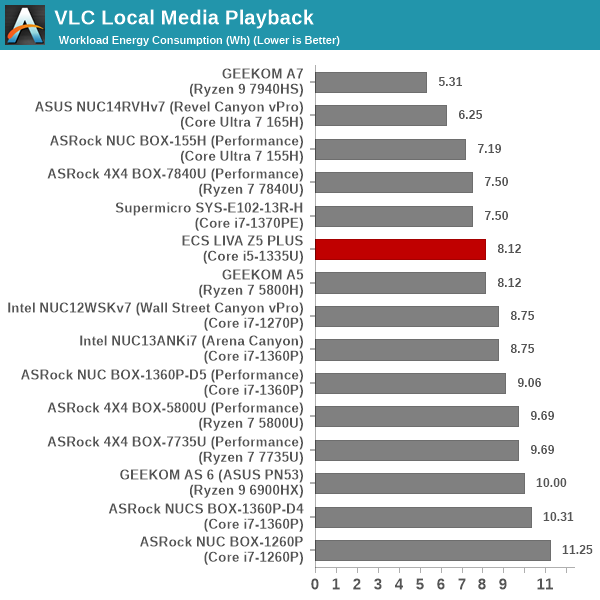
Playback was perfect for all codecs except AV1 (the 8Kp60 decoding was hardware-accelerated, but the presentation lost half the frames), and the power consumption numbers are excellent. The energy consumption numbers land the ECS LIVA Z5 PLUS in the upper half, with the low PL1 configuration being of help here.

The scenario seen with VLC was also observed with Kodi. Absolute energy numbers are a bit higher (as the GPU is kept 'busy' even during the idling period from one clip's playback to the next), but the LIVA Z5 PLUS continues to be relatively energy-efficient.
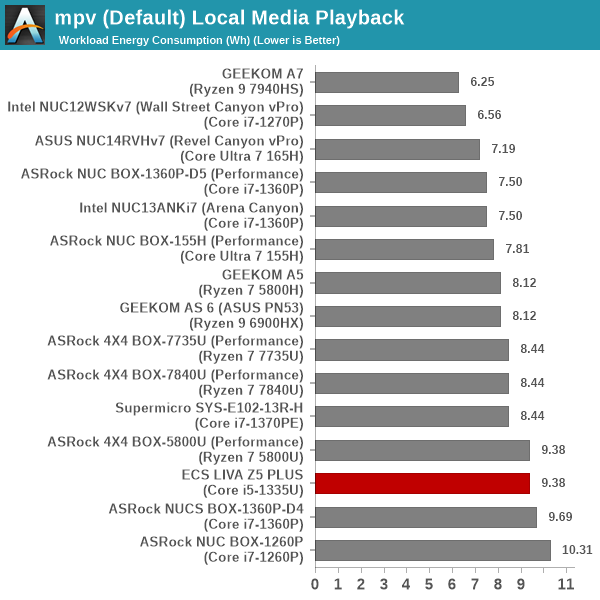

mpv is able to utilize hardware acceleration for all codecs. The 8Kp60 AV1 clip has some presentation issues (with half of the frames getting dropped), but the decoding is done without issues. In terms of energy efficiency, the numbers for the GPU-HQ case are higher, as expected. The activation of the GPU shaders is reflected in the increased D3D Usage, which is also graphed above.


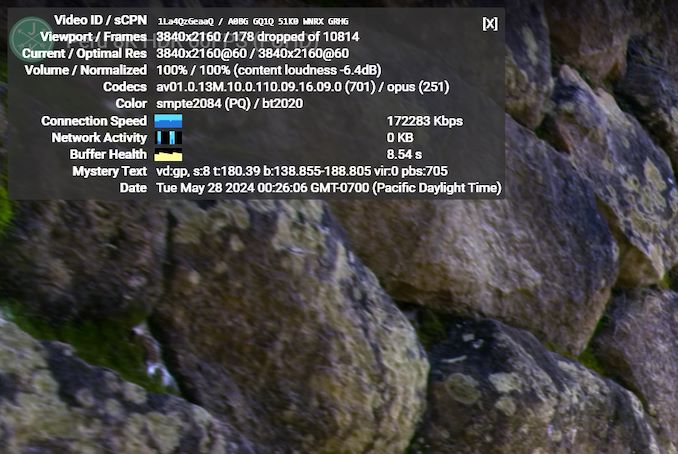
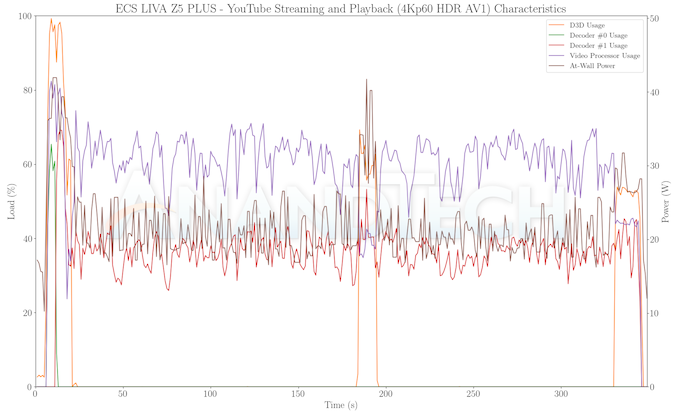
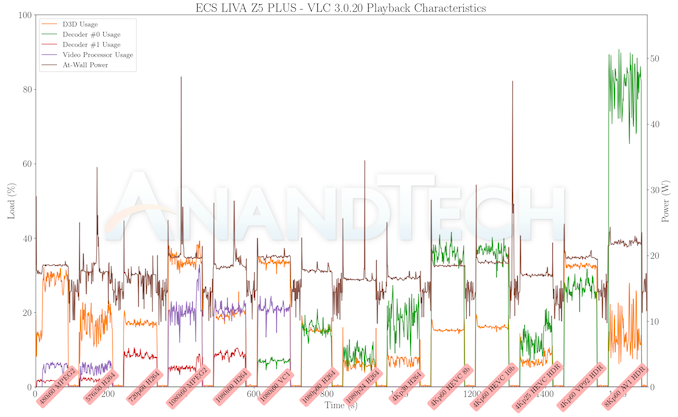


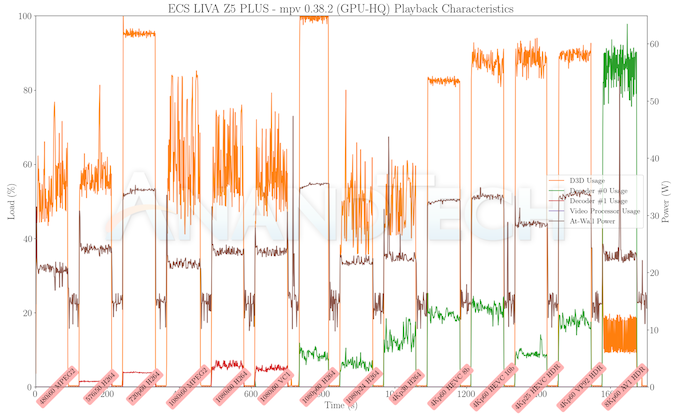








14 Comments
View All Comments
eastcoast_pete - Friday, August 2, 2024 - link
Appreciate the reviews of these compact systems. One remark about the intended use as an "industrial PC": for that, having an additional set (2) of USB 2.0 ports in addition to the USB 3 (A type) and the sole USB 4.0 would have made sense (and there's enough space for them, too). Reason: some peripherals just don't play well with USB 3, for whatever reason. Never mind what the USB standards body says, 100% backward compatibility is not always a given. If your equipment that you want to drive is a USB 2.0 device, it's safer to get something with at least one USB 2 Port.Oxford Guy - Friday, August 2, 2024 - link
'The power limits are conservatively configured at 20W / 39W, which is reasonable for an actively-cooled compact mini-PC targeting the industrial and business markets. It contributes to long-term product reliability.'I didn't see anything about a fan nor fan noise. Did I miss something?
powerarmour - Saturday, August 3, 2024 - link
Who would buy this now with Intel confidence in the toilet, that's the main issue.The_Assimilator - Saturday, August 3, 2024 - link
People who understand that embedded CPUs aren't affected.TheinsanegamerN - Monday, August 5, 2024 - link
*Yet.First it was only i9k,s, then i7 and i9ks, then all ks, then some xeons, then normal chips and T/F series started becoming unstable.
So how long you figure the mobile lineup has?
meacupla - Saturday, August 3, 2024 - link
A U-series i5 using DDR4 is probably unaffected. It's running well under the settings that cause degradation.TheinsanegamerN - Monday, August 5, 2024 - link
Xeons do to, and those have experienced the same failure.meacupla - Monday, August 5, 2024 - link
Can you point to link of Xeon failing from the same problem as the 13/14gen desktop chips?Are you sure you're not mistaking it with the W680 workstation boards used as cheap servers?
Even at PL2, the U series 13th gen is well under the >65W setting that is part of the problem.
sharath.naik - Sunday, August 4, 2024 - link
I just bought a Thinkbook16 7530u for 500$. It has 2 ram slots and 2 SSD slots. Plus has keyboard/ display and battery. Not sure this makes any sense right now.PeachNCream - Sunday, August 4, 2024 - link
That's always been the trouble with the NUC and its clones. You get less computer compared to a laptop of similar price, less portability, and they aren't functional without external hardware. Barebones systems require additional internal hardware and an OS license. Upgrade options are identically limited. There are people to which they'd appeal, but I'd argue that in a fair number of those use cases, a laptop would have been a better choice even if the buyer doesn't feel as special during and after the purchase.